Plants for Autumn Colour
A selection of autumn showstoppers for your green space
As the evenings become darker and mornings get cooler, green spaces evolve and adopt a new colour palette of rich hues, from coloured foliage, flowers, stems, and berries. There is a fantastic array of plants which provide colour and interest throughout autumn—with some extending through to winter.
Autumn can sometimes be known to be the season where bright colours fade and the garden goes over. However, there are many ways to bring a blaze of colour back into your green space, using a selection of perennials, shrubs, ornamental grasses, and trees.
Perennials
Plenty of perennials will keep blooming up until the first frost, especially if faded flowers are pruned to encourage new blooms, and foliage colour can intensify as temperatures drop. Some of our reliable favourites are Aster × frikartii ‘Mönch’, Hylotelephium ‘Purple Emperor’ (Sedum) and Heuchera ‘Red Sea’.
Aster × frikartii ‘Mönch’
One of the longest flowering asters, Aster × frikartii ‘Mönch’ flowers from August to October. With its slender, linear petals, dark foliage and abundance of lavender-blue daisies with yellow centres, it provides excellent colour during the autumn months. Aster × frikartii ‘Mönch’ thrives in full sun or partial shade, in most well-drained soil. These stunning Michaelmas daisies look great as part of a mixed border, amongst other late flowering perennials.
Hylotelephium ‘Purple Emperor’ (Sedum)
Formally known at Sedum, Hylotelephium ‘Purple Emperor’ is a compact perennial with broad, bronze-purple succulent foliage, striking purple stems and masses of red-purple, nectar-rich flower buds in late summer, which darken over time. Eventually, Hylotelephium ‘Purple Emperor’ dies back and its brown, stiff stems provide excellent structural interest throughout winter. Perfect for the front of well-drained, sunny borders, in alkaline or neutral soil.
Heuchera ‘Red Sea’
Heuchera ‘Red Sea’ is an evergreen perennial that retains a great deal of foliage over the winter period. It has striking, marmalade coloured foliage with slender stems that bear small, white flowers from late spring to summer. Moist, well-drained, neutral soil is ideal for Heuchera ‘Red Sea’ and it also prefers a sheltered, sunny or partially shaded spot. Looks great in pots and flower beds, as well as for underplanting shrubs.
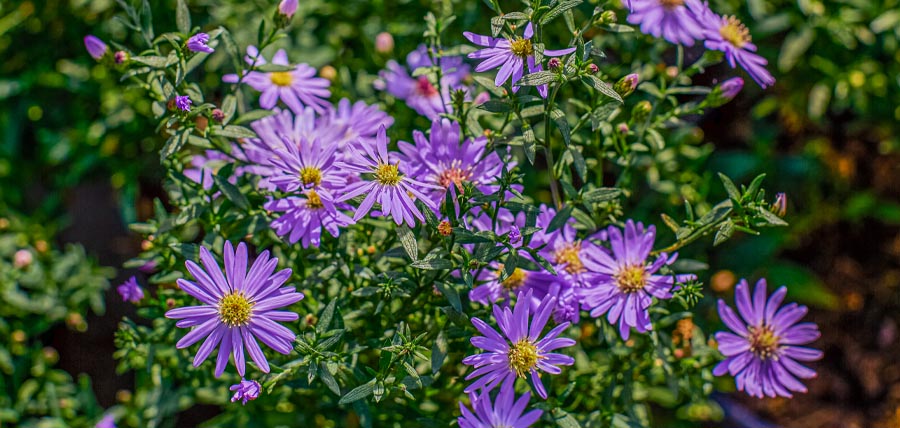
Aster × frikartii ‘Mönch’
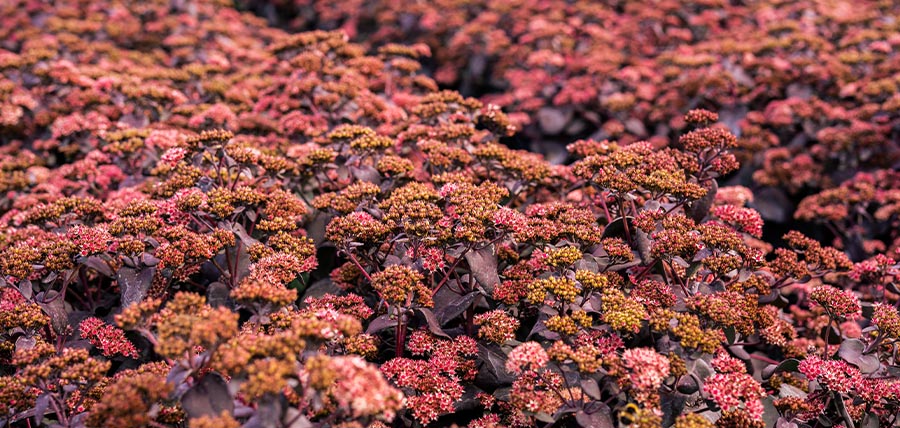
Hylotelephium ‘Purple Emperor’ (Sedum)
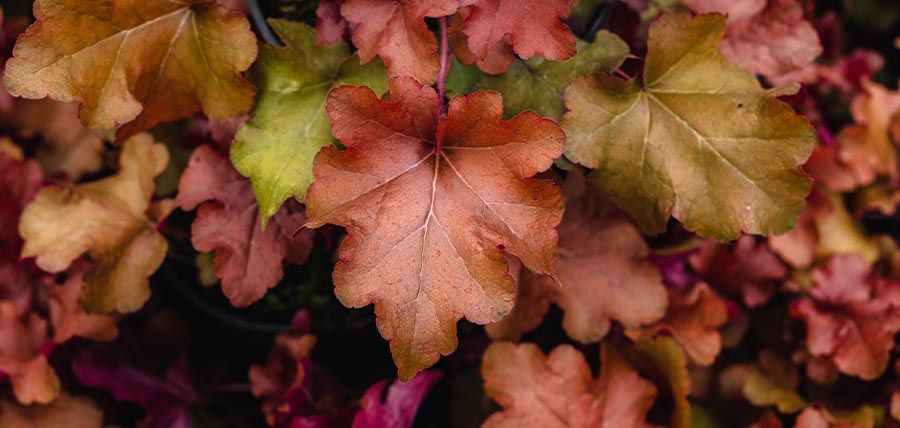
Heuchera ‘Red Sea’
Shrubs
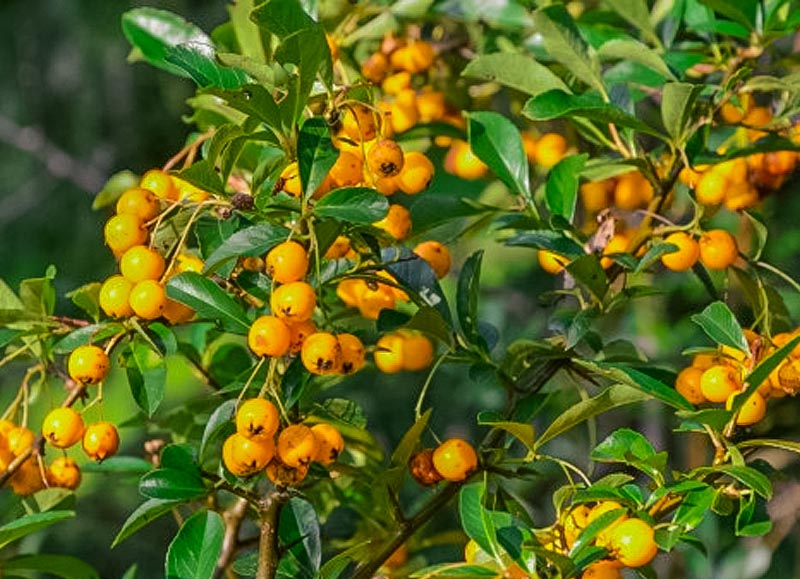
Cotoneaster franchetii (orange cotoneaster)

Cotoneaster × suecicus ‘Coral Beauty’
Shrubs can provide a variety of colours, through foliage, stems, blooms and berries. Some look good all year round, but become especially striking in autumn, which helps to add interest to your green space at this time of year. For a mix of evergreen and deciduous shrubs, we love Cotoneaster franchetii (orange cotoneaster), Cotoneaster × suecicus ‘Coral Beauty’ (cotoneaster ‘Coral Beauty’), Euonymus europaeus (spindle), Berberis thunbergii ‘Orange Sunrise’ (Japanese barberry ‘Orange Sunrise’) and Cornus sanguinea ‘Midwinter Fire’ (dogwood ‘Midwinter Fire’).
Cotoneaster franchetii (orange cotoneaster)
Cotoneaster franchetii is an evergreen shrub that grows up to 3m high. It has grey-green foliage with white undersides, pink-tinted white flowers in summer and striking, orange-red fruits in autumn. With its arching branches and graceful shape, Cotoneaster franchetii works fantastically in a shrub border, or grown as a wall shrub, with support. Cotoneaster franchetii prefers full sun or partial shade, in any moist, well-drained soil.

Euonymus europaeus (spindle) – DM from Flickr
Cotoneaster × suecicus ‘Coral Beauty’ (cotoneaster ‘Coral Beauty’)
A low-growing, evergreen shrub, Cotoneaster × suecicus ‘Coral Beauty’ is ideal for groundcover with its dense, weed smothering, dark green foliage, and grows up to 1m in height. It blooms an abundance of small, white flowers in summer, and orange berries in autumn, for local birds to feed on. Any well-drained soil in a full sun or partially shaded spot will help Cotoneaster × suecicus ‘Coral Beauty’ to thrive.
Euonymus europaeus (spindle)
This deciduous, spreading shrub is commonly known as spindle, and grows up to around 3m in height. Euonymus europaeus has ovate, narrow foliage which starts out green and turns yellow or red in autumn. Whilst its foliage is transitioning, Euonymus europaeus also bears pink fruits, which open to reveal orange seeds; these hang on even after the foliage has fallen. Euonymus europaeus is easy to grow as it tolerates most growing conditions and soils in full sun or partial shade. Great for growing as hedging or as a small tree.
Berberis thunbergii ‘Orange Sunrise’ (Japanese barberry ‘Orange Sunrise’)
Commonly known as Japanese barberry ‘Orange Sunrise’, this deciduous, narrow shrub has a columnar habit. In spring, intensely coral-pink foliage emerges with hanging clusters of small, yellow flowers from late spring to early summer. These are nectar-rich and great for pollinators. By summer, its foliage transitions to red, with yellow-gold margins which last throughout autumn, alongside red berries. Berberis thunbergii ‘Orange Sunrise’ grows up to 1.5m in height and provides great structural interest and colour. Prized for its superb foliage, Berberis thunbergii ‘Orange Sunrise’ is suitable for hedging, containers and borders, in moist but well-drained soil. Full sun is preferred and will enhance the vibrancy of its foliage.
Cornus sanguinea ‘Midwinter Fire’ (dogwood ‘Midwinter Fire’)
Cornus sanguinea ‘Midwinter Fire’—commonly known as dogwood ‘Midwinter Fire’—is known for its flame coloured stems which become brighter during winter. Growing to 2m tall, this spreading, deciduous, reliable shrub has orange-red and yellow young shoots, bearing oval, green foliage and white flowers in summer. Berries appear in autumn, whilst the foliage turns orange-yellow, until it falls and leaves showstopping stems. A full sun position will result in the best colour, and it will thrive in most well-drained soil.

Cornus sanguinea ‘Midwinter Fire’ (dogwood ‘Midwinter Fire’)
Ornamental Grasses
Ornamental grasses are a great way to provide movement, colour and structure to your green space. With their varied shapes, textures and forms, they stand out beautifully and are a low maintenance planting option. In autumn, their inflorescences often change in shape and colour, adding fantastic warm hues, with some lasting into winter. A few of our favourite ornamental grasses for autumn colour are Miscanthus sinensis ‘Flamingo’ (eulalia ‘Flamingo’), Pennisetum × advena ‘Rubrum’ (fountain grass ‘Rubrum’) and Anemanthele lessoniana (pheasant’s tail grass).
Miscanthus sinensis ‘Flamingo’ (eulalia ‘Flamingo’)
Miscanthus sinensis ‘Flamingo’ (eulalia ‘Flamingo’) is a deciduous grass with a stunning, free-hanging form, that grows up to 1.5m in height. It has arching, green foliage with prominent midribs, and in late summer it bears feathery, dark pink inflorescences, which mature to silver. Over time, its foliage matures to orange, which makes for superb autumn colour. Miscanthus sinensis ‘Flamingo’ thrives in full sun, in well-drained soil. Well suited to flower borders and beds.
Pennisetum × advena ‘Rubrum’ (fountain grass ‘Rubrum’)
Commonly known as fountain grass ‘Rubrum’, this ornamental, deciduous grass grows up to 1.5m in height. Strappy, red-burgundy foliage emerges in spring, with graceful, arching stems, bearing silver and red inflorescences in late summer; similar in shape to a bottle-brush. As the plumes age, they transition to brown. Pennisetum × advena ‘Rubrum’ prefers a sheltered spot in full sun and a well-drained soil. Looks exceptionally striking when planted en masse.
Anemanthele lessoniana (pheasant’s tail grass)
This clump forming, evergreen grass has slender, arching leaves which emerge green in spring and later turn red or orange. A slightly shorter grass at 1m in height, Anemanthele lessoniana bears red-brown inflorescences in late summer. Prefers full sun or partial shade, in moist, well-drained soil. An excellent choice for year-round movement, colour and structure.
Trees
Trees can truly put on a dramatic show in autumn; deciduous trees, in particular, are fantastic at this time of year as their production of chlorophyll gradually stops and thus, shades of yellow, orange or red are revealed, before they eventually fall. Not only are they aesthetically pleasing; deciduous trees leave behind piles of brown leaves, which provide excellent homes for wildlife. Some of our favourite trees for showstopping autumn colour are Cercis canadensis ‘Forest Pansy’ (redbud ‘Forest Pansy’); Liquidambar styraciflua (Sweet gum); Malus ‘Evereste’ (crab apple ‘Evereste’); and varieties of Acer palmatum (Japanese maple), such as ‘Katsura’, ‘Orange Dream’ and ‘Osakazuki’.
Liquidambar styraciflua (sweet gum)
A stunning, deciduous tree with an upright habit, Liquidambar styraciflua (sweet gum) has lobed, maple-like, green foliage throughout spring and summer, before it turns orange, red and purple in autumn. Liquidambar styraciflua is a tall tree—growing from 10m to over 20m—and takes around 20 years to reach its full height. Liquidambar styraciflua thrives in acidic or neutral, moist, well-drained soil, in full sun or partial shade.
Liquidambar styraciflua ‘Globosum’ (sweet gum ‘Gum Ball’) is a more compact variety—reaching up to 2.5m—and is often grown as a standard pom pom tree.
Liquidambar styraciflua ‘Lane Roberts’ (sweet gum ‘Lane Roberts’) is a tighter variety, growing taller than 12m, with a narrow habit and larger leaves, which turn from green to dark crimson and purple in autumn. Sometimes it bears clusters of burr-like, green fruit.
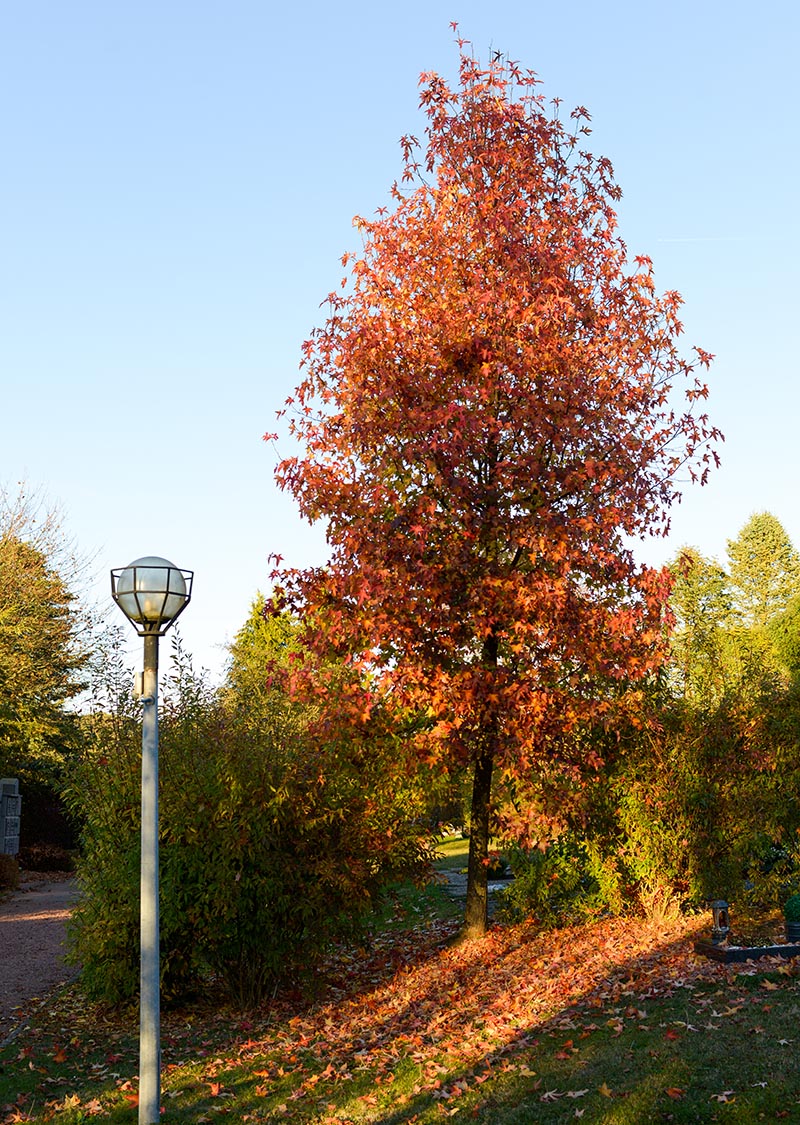
Liquidambar styraciflua (sweet gum) – © Simon Mannweiler / Wikimedia Commons
Cercis canadensis ‘Forest Pansy’ (redbud ‘Forest Pansy’)
Grown for its striking foliage, Cercis canadensis ‘Forest Pansy’ (redbud ‘Forest Pansy’) is a deciduous, multi-stemmed tree that grows up to 8m. Cercis canadensis ‘Forest Pansy’ has clusters of bright pink and occasional white, pea-like flowers on bare stems in spring, before its deep red-purple, heart shaped foliage emerges. Looks great planted in the back of a border or against a wall. Position in full sun or partial shade, in any well-drained soil.

Cercis canadensis ‘Forest Pansy’ detail – Photo by David J. Stang, CC BY-SA 4.0
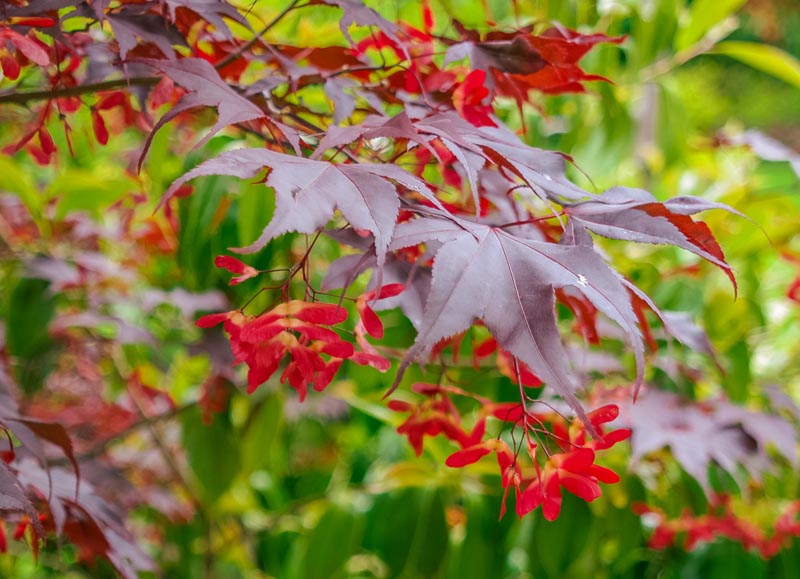
Acer palmatum (Japanese maple)
Malus ‘Evereste’ (crab apple ‘Evereste’)
Malus ‘Evereste’ (crab apple ‘Evereste’) is a deciduous tree with a conical shape, that grows up to 8m in height—ideal for small gardens. It has masses of white flowers which open from red buds in spring, followed by a second show of large, orange-yellow fruit in autumn, creating a stunning focal point. Malus ‘Evereste’ is one of the most disease-resistant varieties of crab apple and it thrives in all well-drained soil, in full sun or partial shade. The best fruit and flower displays will appear when Malus ‘Evereste’ is positioned in full sun.
Acer palmatum (Japanese maple)
Acer palmatum (Japanese maple) is a very popular deciduous species as it offers fantastic architectural interest and striking autumn colour. Perfect for smaller gardens or those with limited space, Acer palmatum grows to around 4m high and provides multiple seasons of interest. Works well in containers or in the back of borders. Acer palmatum thrives in acidic or neutral, moist, well-drained soil. Sheltered, partially shaded positioning is preferred as the foliage can get scorched by the sun and wind.
Acer palmatum ‘Katsura’ has five to seven lobed, golden-orange foliage with pink borders in spring, which turns green in summer, then later changes to bright orange in autumn.
Acer palmatum ‘Orange Dream’ has an open habit and foliage which emerges yellow in spring, alongside purple flowers. Its foliage then changes to green in summer, and finally transitions again to orange-yellow in autumn. Its striking bark is green all year round.
Acer palmatum ‘Osakazuki’ is known for its showstopping autumn colour. Its large, seven lobed leaves emerge green before changing to an impressive scarlet-orange in autumn. It also bears red flowers in spring and red fruits in summer.
Get in touch with our expert G Team if you need advice on plants for autumn colour, or head to our innovative Tender Tool app to get a quick and easy quote.

